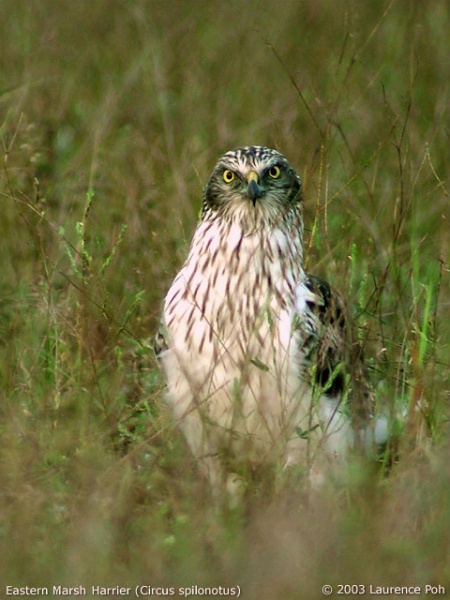| (14 intermediate revisions by 7 users not shown) | |||
| Line 1: | Line 1: | ||
'''Alternative name: Spotted Marsh Harrier''' | '''Alternative name: Spotted Marsh Harrier''' | ||
| + | [[Image:Eastern_Marsh_Harrier.jpg|thumb|450px|right|Photo by the late '''[http://www.birdforum.net/gallery/showgallery.php/ppuser/951/cat/500 Laurence Poh]'''<br />December 2003]] | ||
;[[:Category:Circus|Circus]] spilonotus | ;[[:Category:Circus|Circus]] spilonotus | ||
| − | + | ||
==Identification== | ==Identification== | ||
| − | It is 48 to 58 cm long with a wingspan of 113 to 137 cm | + | It is 48 to 58 cm long with a wingspan of 113 to 137 cm. Like most birds of prey, the female is usually larger than the male.<br /> |
| + | The male's plumage is variable; typically the head, breast, back and wing-coverts are blackish with pale streaks. The rest of the wing is grey with black wingtips and a white front edge. The tail is grey, the rump is white and the underparts are mostly white. | ||
| + | |||
| + | The female is dark brown with buff streaking on the head and underparts. The rump is often whitish and the tail has dark bars. | ||
| + | |||
| + | Young birds are dark brown with buff on the head and a pale patch on the underwing. | ||
==Distribution== | ==Distribution== | ||
| − | Eastern [[Asia]]. Breeds in eastern [[Siberia]] to the Pacific | + | [[Image:Eastern marsh harrier.jpg|thumb|350px|right|Male<br />Photo by {{user|scottishdude|scottishdude}}<br />Shenyang, [[China]], June 2008]] |
| + | Eastern [[Asia]]. Breeds in eastern [[Siberia]] to the Pacific coast and Sakhalin, in north-east [[India]], throughout [[China]] and in Hokkaido and Honshu in [[Japan]]. Also breeds in the [[Philippines]], and [[Indonesia]]. | ||
Resident in southern [[China]] but a summer visitor to north of breeding range wintering from southern [[China]], [[Taiwan]] and Hainan south to [[Indonesia]]. | Resident in southern [[China]] but a summer visitor to north of breeding range wintering from southern [[China]], [[Taiwan]] and Hainan south to [[Indonesia]]. | ||
==Taxonomy== | ==Taxonomy== | ||
| − | + | This is a [[Dictionary_M-S#M|monotypic]] species<sup>[[#References|[1]]]</sup>. | |
| − | + | ||
| − | + | [[Papuan Harrier]] was recently split from Eastern Marsh Harrier. | |
| + | [[Image:10256IMG 5398-800x600.jpg|thumb|250px|right|Juvenile male<br />Photo by {{user|Romy+Ocon|Romy Ocon}}<br />Malasi Lake, Isabela Province, [[Philippines]], January 2007]] | ||
==Habitat== | ==Habitat== | ||
| − | Plains, paddyfields and swamps. | + | Plains, paddyfields and swamps. |
==Behaviour== | ==Behaviour== | ||
| − | While hunting it flies low over the ground with the wings held in a shallow V-shape. Its prey includes small mammals, birds and frogs. | + | ====Flight==== |
| − | + | While hunting it flies low over the ground with the wings held in a shallow V-shape. | |
| + | ====Diet==== | ||
| + | Its prey includes small mammals, birds and frogs. | ||
| + | ====Breeding==== | ||
The breeding season begins in April. The nest is made of sticks and built on the ground, usually in a reedbed. Four to seven eggs are laid which are incubated for 33 to 48 days. The young birds fledge after 35 to 40 days. | The breeding season begins in April. The nest is made of sticks and built on the ground, usually in a reedbed. Four to seven eggs are laid which are incubated for 33 to 48 days. The young birds fledge after 35 to 40 days. | ||
| + | ==References== | ||
| + | #{{Ref-Clements6thAug19}} | ||
| + | {{ref}} | ||
==External Links== | ==External Links== | ||
{{GSearch|Circus+spilonotus}} | {{GSearch|Circus+spilonotus}} | ||
| − | |||
[[Category:Birds]][[Category:Circus]] | [[Category:Birds]][[Category:Circus]] | ||
Latest revision as of 01:57, 7 February 2021
Alternative name: Spotted Marsh Harrier
- Circus spilonotus
Identification
It is 48 to 58 cm long with a wingspan of 113 to 137 cm. Like most birds of prey, the female is usually larger than the male.
The male's plumage is variable; typically the head, breast, back and wing-coverts are blackish with pale streaks. The rest of the wing is grey with black wingtips and a white front edge. The tail is grey, the rump is white and the underparts are mostly white.
The female is dark brown with buff streaking on the head and underparts. The rump is often whitish and the tail has dark bars.
Young birds are dark brown with buff on the head and a pale patch on the underwing.
Distribution
Eastern Asia. Breeds in eastern Siberia to the Pacific coast and Sakhalin, in north-east India, throughout China and in Hokkaido and Honshu in Japan. Also breeds in the Philippines, and Indonesia. Resident in southern China but a summer visitor to north of breeding range wintering from southern China, Taiwan and Hainan south to Indonesia.
Taxonomy
This is a monotypic species[1].
Papuan Harrier was recently split from Eastern Marsh Harrier.
Habitat
Plains, paddyfields and swamps.
Behaviour
Flight
While hunting it flies low over the ground with the wings held in a shallow V-shape.
Diet
Its prey includes small mammals, birds and frogs.
Breeding
The breeding season begins in April. The nest is made of sticks and built on the ground, usually in a reedbed. Four to seven eggs are laid which are incubated for 33 to 48 days. The young birds fledge after 35 to 40 days.
References
- Clements, J. F., T. S. Schulenberg, M. J. Iliff, S. M. Billerman, T. A. Fredericks, B. L. Sullivan, and C. L. Wood. 2019. The eBird/Clements Checklist of Birds of the World: v2019. Downloaded from http://www.birds.cornell.edu/clementschecklist/download/
Recommended Citation
- BirdForum Opus contributors. (2024) Eastern Marsh Harrier. In: BirdForum, the forum for wild birds and birding. Retrieved 22 November 2024 from https://www.birdforum.net/opus/Eastern_Marsh_Harrier






